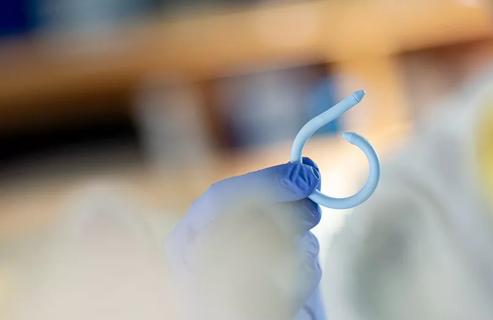Study reinforces the benefits of using cystatin C

A new study led by investigators at Cleveland Clinic calls into question the accuracy of serum creatinine when estimating kidney function of individuals who are nonweight-bearing. Findings from the study suggest creatinine-based estimated glomerular filtration rate (eGFR) equations alone may be inaccurate, and cystatin C or combined eGFR equations may be a more accurate assessment of kidney function in this patient population.
Advertisement
Cleveland Clinic is a non-profit academic medical center. Advertising on our site helps support our mission. We do not endorse non-Cleveland Clinic products or services. Policy
Creatinine-based eGFR equations have been primarily validated in patients who are weight-bearing. However, since creatinine levels are contingent upon muscle mass, they may not accurately reflect kidney function in a nonweight-bearing population at risk of sarcopenia.
Urologist Hadley Wood, MD, who specializes in the urological management of patients with acquired and congenital spinal diseases, says she’s long surmised that creatinine is a suboptimal measure for kidney function in this patient population, since creatinine is a byproduct of muscle breakdown, most of which is derived from weight bearing.
“Someone who isn’t ambulating or has undergone leg amputation is not going to have creatinine production normalized to weight-bearing patients, and, therefore, their creatinine will never be a good marker of how well their kidneys are filtering,” says Dr. Wood, senior author of the study published in the Journal of Urology. She continues, “Having an accessible and reliable measure of renal function has been a problem that I’ve been trying to crack my entire career.”
The main advantage of identifying a truly accurate eGFR, explains Cleveland Clinic nephrologist Jonathan Taliercio, DO, co-author of the study, is recognizing the presence and cause of kidney disease and trying to prevent its progression through lifestyle modification and medications. “We know that there is a stepwise increased risk of death associated with the severity of kidney disease,” he says. And patients with neurogenic lower urinary tract dysfunction are already at greater risk for kidney dysfunction.
Advertisement
In 2021, the National Kidney Foundation and the American Society of Nephrology published a recommendation to adopt a new set of equations, free of a race variable, to estimate kidney function.
The organizations endorsed the 2021 Chronic Kidney Disease (CKD)-Epidemiology (EPI) equations to be used with creatinine or cystatin C alone or a combination of the two. These calculations have been validated in an ambulating population but not in nonweight-bearing individuals.
The authors reviewed Cleveland Clinic adult records with a diagnostic code indicating nonweight-bearing status. They calculated the respective eGFR using the 2021 CKD-EPI equations — with creatinine (CKD-EPICr), cystatin C (CKD-EPICys), and a combination (CKD-EPICr+Cys). The eGFR was significantly lower when calculated with cystatin C compared to creatinine. And the differences in eGFR values were more varied in the nonweight-bearing cohort (N = 102) relative to the matched ambulatory control cohort (N = 204) (P < .001).
In a separate analysis, the research team matched available imaging and/or evidence of proteinuria in nonweight-bearing individuals, again showing variation among the three calculations. (P < .001). This led to the reclassification of 58% of nonweight-bearing individuals to a lower eGFR when using cystatin C, as opposed to creatinine.
This is important because a lower eGFR may warrant a nephrology referral and change the course of management, explains Dr. Taliercio. “Depending on the cause and severity of the kidney disease, a clinician may choose more aggressive medical management strategies to prevent progression, which usually includes hypertension and diabetes control, and minimizing NSAID use.”
Advertisement
Comparing the respective equations to the gold standard for GFR measurement, an iothalamate nuclear renal scan, may clarify which biomarker better approximates kidney function. But nuclear renal scanning isn’t practical for every patient — these studies can be cumbersome, are not always available, and take several hours to complete. Further, a patient with urinary incontinence may require a urinary catheter to complete the study.
As a next step, the researchers plan to identify nonweight-bearing individuals with a wide discrepancy in eGFR values, complete an iothalamate study, and “triangulate the truth,” says Dr. Wood. Findings could confirm that the use of cystatin C is optimal in nonweight-bearing individuals, or it might indicate the need to generate a new equation or adjust the existing one.
Advertisement
Advertisement

The low anterior access approach using the single-port robot is gaining attention within the field

Revolutionizing pediatric urology with a new, less invasive approach

What it could mean for the future of ambulatory monitoring for bladder conditions

Cleveland Clinic surgeons describe a new technique for harvesting a rectal mucosa graft

New study sheds light on national trends in urology residency, former CCLCM alum comments

Historic collaboration connects two Cleveland Clinic locations, enables real-time sharing of metrics and surgical progress

Retrospective study evaluates clinical upstaging during neoadjuvant treatment

Retrospective study finds acceptable cancer control among most histologic subtypes with intravesical therapy